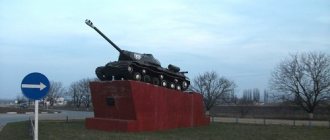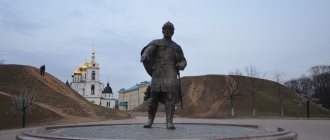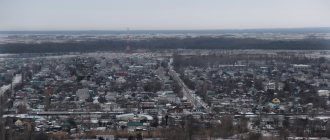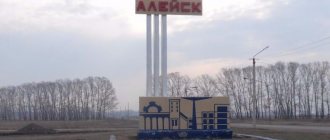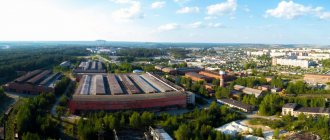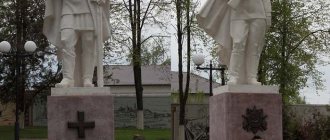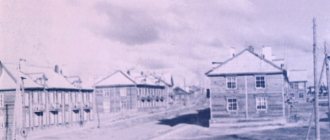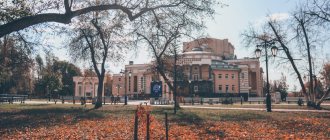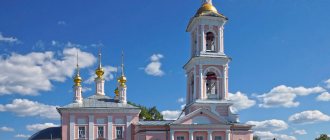About the city of Kozelsk: description and history
Kozelsk is a small town, occupying an area not exceeding 25 square kilometers, and located on the banks of the Zhizdra River, a tributary of the Oka. It is part of the Kaluga region. The city's population is small - less than 17 thousand people.
Kozelsk is the oldest city in the Kaluga region, the administrative center of the Kozelsky district
The history of the city begins in 1146 - it was in this year that Kozelsk was first mentioned in chronicles. But even before the founding of the city, tribes of Slavic Vyatichi lived on its territory. From the moment of its inception, Kozelsk was part of the Chernigov principality, and later was annexed to Novgorod-Seversky. After a short period, the city began to function as an independent fief, where its own prince ruled. The first ruler of Kozelsk was Prince Mstislav Svyatoslavovich, who died in the battle on the Kalka River in 1223. His son Vasily became the next city manager, but he also suffered an unenviable fate - in 1238 the city was attacked by the army of Batu Khan. The inhabitants of Kozelsk defended themselves for seven long weeks, destroyed most of the Tatar-Mongol warriors, but were still defeated. The khan's sons died in the battle; he became angry with Kozelsk, he nicknamed it "the evil city", killed all its inhabitants, including Prince Vasily, and completely destroyed the settlement itself in fire.
Kozelsk suffered from fires several times
Having recovered, the city came under the jurisdiction of the Karachev Principality, then became part of Lithuania, and at the end of the 15th century became part of the Moscow Principality. Under Ivan IV, a fortress wall was built around the city, but it did not save Kozelsk from plunder by Polish-Lithuanian invaders at the beginning of the 17th century.
In 1719, the city became part of the Kaluga province, later becoming its district town. Craft and trade activities, as well as industry, were poorly developed in Kozelsk. The main purpose of the city of that period was to serve as a transit point on the way from Russia to Ukraine. At the end of the 18th century, the city was engulfed in fire, destroying most of it. Restoration was slow; by the end of the next century, there were no more than a thousand houses in Kozelsk, and no more than fifty stone ones. The economic and trade component in the city was still undeveloped, as a result of which the population moved to other settlements. During the Great Patriotic War, Kozelsk was captured by the Germans for two months. In 2009, the city received the status of “City of Military Glory”. Today Kozelsk is a provincial town in which several industrial enterprises operate.
"Ogonyok" visited the small homeland of Nikolai Karamzin
The official part is coming to an end, but here the guide, local historian and secretary of the Kozelsky Society of Russian Literary People Galina Gorokhova takes the floor:
“It was here, in Kozelsk, that the principle of “die but not surrender” was born, which later passed through the entire Russian history,” she instructs schoolchildren. “When the enemy comes, we must be united.” After all, we still remain a city of warriors, because in our forests we have part of the nuclear shield of the Motherland.
It’s true, the Strategic Missile Forces division is based in Kozelsk. Launch silos are hidden in the surrounding thickets; in the city itself there is a headquarters, a parade ground, an army cultural center, economic services and a huge military camp. The division is one of two city-forming enterprises. The second is located a few kilometers from the city of Optina Pustyn. That's why there are a lot of out-of-towners in Kozelsk. Some came to serve in the division, others came to pray in the desert. Galina Eduardovna and her husband are from the last category, they are originally from Moscow. It just so happened that all Kozel local historians are not from here.
What would Kozelsk be without goats?
Photo: Dmitry Lebedev, Kommersant
In the end, Galina Gorokhova moves from high matters to low ones. It turns out that the residents of Deshovoki have been looking for treasure in the vicinity of the village of Batu for many centuries. Allegedly, during the siege of Kozelsk, the khan’s daughter caught a cold and died. They buried her here along with the golden boat.
“You definitely have to look for the treasure on Easter night.” Not to go to church, but to the mound! - the speaker says. - Then a cave opens there, there are some kind of witch frogs in it, and if something is done incorrectly, the treasure hunter dies. Grandmothers tell this from generation to generation like a fairy tale. But our women told me: it may be a fairy tale, but this guy died, another died.
The meeting is over, in just a minute the schoolchildren get dressed and disappear through the door. Workers of the Deshov cultural center sit down for tea and remember the local treasure hunters:
“Indeed, my mother-in-law told me that her relative was also digging and died.
“And I heard from our former director: her husband kept digging the ground, looking for treasure, and then he died.”
Table: how to get to Kozelsk
| Departure point | Bus | Automobile |
| Moscow | More than ten buses depart from the Teply Stan bus station every day. Travel time: just over 5 hours. Cost of the trip: from 740 rubles. | Distance between cities: 251 kilometers. Travel time: 2–3 hours. Route: M3. |
| Saint Petersburg | There are no direct flights. | Route length: 919 kilometers. Travel time: 9–11 hours. Routes: M10, A108, M3. |
| Kaluga | Buses depart every 5–60 minutes. Travel time: about 2 hours. Ticket price: from 200 rubles. | Distance between cities: 72 kilometers. Travel time: about an hour. Route: P132. |
Transport[ | ]
- Single-track non-electrified line Smolensk - Tula with a branch to Belyov. Railway stations Kozelsk and Tupik.
- Highway to Kaluga
- Automobile access to the M3 "Ukraine" highway
Intercity buses depart daily from the city bus station to Kaluga, Moscow and once every two days to Voronezh. The city is also connected by suburban bus service to some settlements in the region and the neighboring regional center of Sukhinichi.
Intra-city car traffic is small, only three intersections are equipped with traffic lights[38].
Sights of Kozelsk
The sights of the city of Kozelsk are represented by ancient churches and monasteries, museum exhibitions, as well as unusual parks and picturesque natural monuments.
Vvedensky stauropegial monastery Optina Pustyn
The monastery was founded in the 14th century by a former robber, the hermit Optius, in whose honor it received its name. In the 19th century, the monastery served as the main spiritual center of the country. Famous personalities often came here, including: Fyodor Mikhailovich Dostoevsky, Lev Nikolaevich Tolstoy. During the Soviet period, the desert was closed, but its revival occurred at the end of the 20th century. Today, monastic life has already been resumed, but the restoration of buildings continues.
Optina Pustyn is without a doubt one of the holiest Orthodox places in Russia
Among the auxiliary buildings on the territory of the monastery there are:
- two cell buildings;
- horse yard;
- a wall with six towers and a sacred gate;
- hotel;
- church store;
- abbot and bakery buildings;
- library;
- refectory;
- belfry;
- several chapels;
- bell tower, built at the beginning of the nineteenth century and reaching a height of sixty-four meters.
The bell tower of the Optina Monastery was built from 1801 to 1804, designed in the style of classicism, has four tiers
The desert also includes six temples:
- Vvedensky Cathedral. This is the main and oldest church of the monastery - built in the second third of the 18th century.
The church contains the holy relics of Saints Ambrose and Nektarios, the elders of Optina, as well as the especially revered Kazan Icon of the Mother of God - Kazan Church. The temple is the largest in the monastery. It was built at the very beginning of the 19th century, and its walls are decorated with frescoes.
In the temple there are St. the relics of the venerable Optina elders Moses, Anthony and Isaac I, the relics rest in secret, on top there are marble tombstones with reliquaries for the veneration of believers - Vladimir Church. The church is the tomb for seven Optina monks. It was erected in 1998.
In the temple there are St. relics of the venerable elders of Optina: Leo, Macarius, Hilarion, Anatoly (Zertsalov), Barsanuphius, Anatoly (Potapov), Joseph - Church of the Transfiguration. This is one of the new desert temples - it appeared in 2007.
In the temple there are the relics of St. Raphael (Sheichenko), confessor - Temple in honor of the Venerable Mary of Egypt. The building was erected in 1824 as a refectory, and later, after the appearance of a new refectory building, it was rebuilt into a church. Today the temple also houses an icon painters' workshop.
The temple is currently being restored and restored. - Gate Vladimir Church. It was erected in the first third of the 19th century as a gate tower. At the end of the 20th century, a church was opened in the building.
In addition, the monastery has the St. John the Baptist monastery, in which there are two churches:
- St. John the Baptist Church, built in 1825. In this temple, services are performed according to a special skete charter; pilgrims are allowed to these services only four times a year: the Nativity of John the Baptist, the Council of John the Baptist, the Beheading and Monday of Bright Week.
- Church in honor of St. Leo of Katansky and St. John of Rila. The temple was built at the very beginning of the twentieth century. Today the entrance to the church is closed, and part of the building is occupied by a pilgrimage hotel. In the lower semi-basement, work is underway to recreate the temple in honor of Archangel Michael
Address: Zapadnaya st., vl. 2. Open: daily, 5:00–22:00.
Photo gallery: other buildings of Optina Pustyn
Temple in honor of St. Hilarion the Great is located outside the walls of the monastery, in the same building with the hotel and pilgrimage refectory
The temple in honor of the icon of the Mother of God “Spreader of the Loaves” is located on the territory of the monastery’s subsidiary farm, where the Incessant Psalter is read around the clock
The mobile temple in honor of the icon of the Mother of God “Life-Giving Source” is intended for worship at the site of seasonal field work. The temple in honor of All Saints is located in the former new monastery cemetery outside the monastery fence
The chapel at the burial site of the murdered Optina brethren: Hieromonk Vasily, monks Trofim and Ferapont was built in 2008, located in the monastery cemetery
The Holy Gate was built in the first third of the 19th century
The desert is surrounded by a high stone fence in the form of a regular quadrangle
Kazan Ambrosievsky Shamordino Monastery
The monastery is for women, founded at the end of the 19th century. By the time the power of the Soviets was established, there were approximately 800 nuns in the monastery, who after its abolition were exiled to Siberia. The buildings of the monastery were given to the Agricultural College, and during the Great Patriotic War they housed a military hospital, in which not a single wounded person died. In 1990, the monastery was revived and today is open to the public.
The territory of the monastery includes:
- Kazan Cathedral. The temple is the main one in the monastery. It was built in 1901 and has architecture in the Old Russian style. The building area is so large that it can accommodate more than five thousand believers at a time.
The majestic 15-domed cathedral is decorated with decorative kokoshniks, half-columns, gables, valances, and patterned trim on the arched windows. - Temple in honor of the Holy Trinity. The church is the oldest temple in the monastery. It was erected in 1884, but during the abolition of the monastery the building was demolished. The restoration of the church took place at the beginning of the 21st century.
Behind the temple there is an old monastery cemetery, where several generations of Shamordin sisters found their resting place - Temple in honor of St. Ambrose of Optina. The church appeared in the monastery in 1996 on the site of the house in which Elder Ambrose stayed during his visits to the monastery.
In this church, Father Ambrose went to the Lord in October 1891 - Church in honor of the icon of the Mother of God “Quench my sorrows.” The temple was built and consecrated at the beginning of the twentieth century.
With the resumption of monastic life in the Shamordino desert, the temple in honor of the icon of the Mother of God “Quench my sorrows” was the first to be restored and consecrated on May 27, 1990 - House of S.V. Perlov, built in the 19th century. Sergei Vasilyevich Perlov was a benefactor of the monastery, and when he came to the monastery, he lived in this building. Now the building is used as a refectory, which can accommodate 500 people at a time. The monastery refectory was built in 1893
- Water tower built in 1906.
The water tower provides water to the entire monastery - Hospital building.
On the ground floor of the hospital there is a hospital with ten beds, an outpatient clinic with a reception room, a dressing room, a physiotherapy room, a laboratory and a treatment room, as well as a dental office; monastery workshops are located on the second floor - The tomb in which the abbess and nuns of the monastery are buried.
- Three holy springs.
At the foot of the picturesque hill on which the monastery is located, the Serena River flows, fed by the waters of numerous springs, which are holy springs
Address: Kozelsky district, Shamordino village. Open: daily, 6:00–21:00.
Savior Not Made by Hands of the Deserts
In 1820, an ancient icon of the Savior Not Made by Hands was brought to the village of Klykovo, where the monastery is now located. At that time, a cholera epidemic was raging in the settlement, but after the appearance of the Image here, the disease subsided. In honor of the miraculous event, it was decided to rebuild the old wooden church from stone and consecrate it in honor of the Savior not made by hands. Construction was completed in 1829. In Soviet times, monks from the closed Optina Hermitage settled next to the temple, but not for long - the Church of the Savior Not Made by Hands was also closed in 1937. The building was used for warehouses and workshops, which led to partial destruction of the building. The return of the temple to the church took place in 1991, and over the next eight years its reconstruction took place. The opening of the temple, and with it the monastery, took place in 2001. Today there are two temples, a bell tower and a house church.
Address: Kaluga region, Kozelsky district, p/o Bogdanovka, village. Klykovo. Visiting hours: 9.00–18.00.
Photo gallery: buildings of the Savior Not Made by Hands in the desert
The temple in honor of the Savior Not Made by Hands was built in the Baroque architectural style
The Church of the Hieromartyr Kuksha of Kiev-Pechersk was built in 2007
The bell tower was erected in the 21st century
Assumption Cathedral
The Assumption Cathedral is the cathedral church of the city. It was founded in 1824 and has classical architecture. The cathedral was abolished during the period of Soviet power, at that time the House of Social Culture functioned within its walls. During the occupation of Kozelsk, the church housed a German stable, and in the post-war period - a House of Culture. All this had a bad effect on the building; it practically collapsed. Restoration began after the cathedral was returned to the church - at the end of 2001. To date, the reconstruction has been completed and the temple is welcoming believers again.
Address: st. Bolshaya Sovetskaya, 8.
According to legend, the Assumption Cathedral was built on the site where in 1238 there was a wooden church, in which the last defenders of the city closed themselves and burned alive, but did not surrender into the hands of the Tatar-Mongols
Church of the Annunciation of the Blessed Virgin Mary
The construction of the temple began in 1810 with the money of Lieutenant Rachmaninov. The architecture of the building belongs to the Russian classical style. 60 years after the church was built, a refectory was added to it through donations. There was also a library, a parish school and an unofficial monastic community. Towards the middle of the twentieth century, the church was closed by order of the Soviet government and looted. The resumption of services occurred with the beginning of the Great Patriotic War. Since that period, the church has not stopped its activities.
Address: st. Krasnoarmeyskaya, 25.
It is known that around the temple there was a cemetery for the clergy and famous people of the city of Kozelsk, but after 1937 the tombstones were destroyed and the graves were razed to the ground
Temple of St. Nicholas Myra of Lycia (Temple of St. Nicholas the Wonderworker)
St. Nicholas Church appeared in 1740 thanks to the patron of Optina Hermitage. The style of construction chosen was Baroque. In 1777, there was a fire in which the building was badly damaged, but it was completely restored in just a year. At the end of the 19th century, the church was expanded with additional chapels and a refectory hall. Like most churches, Nikolsky was abolished during the establishment of Soviet power in the country, and a grain storage facility was located within its walls. During the Second World War, the church housed an NKVD warehouse, which was set on fire, causing the church building to be seriously destroyed. The building was not restored; until 1994 it was used for economic purposes. After the building was returned to the Russian Orthodox Church, it began to be restored, and in 1997 it was opened for worship.
Address: st. Zemlyanoy Val, 2, building 1.
The brick church was built at the expense of Chief Marshal D. A. Shepelev, compositionally in many ways similar to the Moscow Church of St. John the Warrior on Yakimanka
Spiritual Communion Church
The church was erected at the expense of a Kozel merchant in 1789. The architecture is dominated by features of the Baroque style. In the 19th century, the building was supplemented with a three-tier bell tower. In 1923, the church ceased to function, and its premises were occupied by warehouses, which had a deplorable effect on the external and internal appearance of the building. The restoration of the temple was carried out in 1988, and was timed to coincide with the anniversary of the battle with the Tatar-Mongols. The return of the church to the believers took place in 1995, and services resumed at the same time.
Address: st. Kuznechnaya, 2.
In 2010, the temple was painted by artist A. Yu. Ivanov
Church of the Conception of John the Baptist
The church is located in the village of Gubino. It was built in 1706 and was once part of a large manor complex. However, of all the buildings, only this temple has survived, and even that is in a dilapidated state. During the Soviet period, the building housed a grain storage facility, which is why the church was destroyed. Restoration of the temple is not yet planned, but it retains its general outline to this day. In addition, remains of frescoes can be found inside the building.
Address: Gubino village.
Now the former Baroque temple is an abandoned church in need of restoration
Museum of Local Lore
The founding date of the Kozel Local History Museum is considered to be 1957. The establishment belongs to the Kaluga Regional Museum of Local History. Initially, the museum was based in the buildings of Optina Pustyn, and today it is located in a merchant mansion of the 19th century, which once belonged to the Tsyplakov family.
The Museum of Local Lore moved to the merchant's house in 1998
The museum exhibits introduce visitors to the history of the Kozelsky region starting from the Stone Age. The most popular item on display in the museum is a diorama dedicated to the defense of the city in 1238. Its author is N. A. Rashchektaev.
Reference:
- address: st. B. Sovetskaya, 75;
- the museum is open: from 10:00 to 17:00;
- Day off is Monday. The last Friday of the month is a sanitary day;
- entrance ticket price: 50 rubles for adults, 40 rubles for pensioners, 20 rubles for schoolchildren.
Photo gallery: exhibits of the Museum of Local Lore
The diorama was created in 1988 for the 750th anniversary of the battle
In the hall dedicated to the Great Patriotic War, personal belongings of Kozel residents (awards, documents, letters) and weapons of those times are presented
The museum tells in detail about the history of the city, showing household items of ancient local residents
One of the halls of the museum is dedicated to the history of the Optina Hermitage; icons, monastic objects, handwritten books of the 17th-19th centuries are presented here. The first hall displays exhibits found during excavations in the vicinity of Kozelsk
Forest Museum "Forest Origins"
"Forest Origins" began its work in 2001. The exhibition is quite unique, there are few like it. Its appearance in Kozelsk is due to the fact that it was in this city that the Forestry Institute first began teaching the basics of forestry in the Russian Empire. The museum is located in Kozelsky forestry. The exhibition tells the story of the history of regional forestry and gives an idea of the flora and fauna of the city and its surroundings. The museum also has a hall dedicated to wooden Russian architecture.
Address: st. Lesnaya, 12.
The exhibition reflects the history of forestry and forestry institutions of the region since the time of Ivan the Terrible, tells about the flora and fauna of the Kaluga region
Memorial Square of Heroes
The central place on the square is occupied by a chapel made of marble and consecrated in the name of All Saints. Not far from the building there are monuments to soldiers: one is dedicated to the heroes who defended the city from the Tatar-Mongols, and the second to the soldiers of the Great Patriotic War. Also on the square is the “Grieving Mother” memorial, next to which the Eternal Flame burns. The graves of soldiers are also located here, about a thousand graves in total.
The most sacred place in the city of military glory is the Heroes Memorial Square. In Soviet times, it was here that schoolchildren were accepted as pioneers, and from here conscripts to serve in the Soviet army were solemnly escorted
In honor of the events of 1238, a column and a stone cross rise on the square. The cross is one of the oldest monuments in the Kaluga region. According to historical information, it was created back in the 5th century. Experts claim that the cross is made of stone, which originally had a different shape - in the form of a female goddess. The monument served as an idol for the pagan Vyatichi tribes who lived here several centuries ago. After the baptism of Rus', the stone was given the shape of a cross. After the destruction of the city by Batu Khan, the monument was erected at the burial site of the dead Kozel residents, and during Soviet times it was removed to the warehouse of the Local History Museum, where it is now located. A copy of the ancient monument is on display.
Another attraction of the square is the forty-meter Wall of Glory, which depicts the entire history of the city of Kozelsk. In addition, the park area contains the “Wheel of Time” fountain: a wheel made of marble spins under the influence of the flow of water.
Address: st. Bolshaya Sovetskaya, opposite house No. 46.
Photo gallery: sights of Heroes Memorial Square
The Kozelsky stone cross is the oldest stone sculpture in the Kaluga region
The chapel in the name of All Saints who shone in the Russian land was built in 2010
The most important events in the history of Kozelsk, which occurred from 1146 to 2009, are depicted on the Wall of Glory
Taking pictures through the Fountain Wheel has become a good tradition among the townspeople and guests of Kozelsk
Military Glory Square
The square appeared in Kozelsk in 2009, immediately after the city was awarded the title of “City of Military Glory.” The main attraction of the square is a granite stele topped with a double-headed eagle. The ensemble is complemented by fountains, which are a smaller copy of the capital’s fountains installed on Poklonnaya Hill.
Address: Kozelsk st. Chkalova (between houses 12 and 23).
The seven-ton pedestal and nine-ton column are made of Karelian granite
City Park
A fascinating exhibit of the City Park is a copy of part of the ancient fortress wall with a wooden turret, which served Kozelsk in defense against the attack of Batu Khan. Today the tower is used as an observation deck from which you can see picturesque “pictures” of Kozelsk and its surroundings, the Optina Hermitage and the Zhizdra River. There is also a fountain in the park complex.
Address: st. Bolshaya Sovetskaya (next to building 4).
The tower is a reconstruction of an ancient building from the 13th century
Reserve "Kozelskie Zaseki"
The reserve is one of the most fascinating ecological monuments in the area. There are preserved fences created by local residents for security purposes back in the 16th-17th centuries. Multi-species broad-leaved trees grow on the territory of the reserve.
The Kozelskie Zaseki nature reserve complex is still very young: its history goes back a little over thirty years.
The reserve has its own museum of the same name. It tells in detail about the defensive structures, the Kozelsk fortress and its abatis. The museum also displays models of fortifications and maps of the area.
Address: Kaluga region, Kozelsky district, Berezichskoye forestry.
Estate "Berezichi"
The estate is located on the banks of the Zhizdra, six kilometers from the city. Prince A.D. Obolensky, who belonged to the old Russian family of Chernigov and Prince Rurik, once lived here. Obolensky's appearance in Berezichi was justified by the fact that he was chosen for the post of Kaluga governor, which the prince held during 1825–1831.
The estate was visited at different times by Count L.N. Tolstoy, N.G. Rubinstein, Rimsky-Korsakov. N.N. Strakhov
Obolensky acquired the estate, which he completely rebuilt. First, in 1845, the St. Nicholas Church was erected. Then a new manor house, which was built under the direction of the architect A. Haveman and was completed at the beginning of the twentieth century. Also, the territory of the estate included a square with alleys, a garden with fruit trees, a gazebo, a fence and the main gate. After Prince Obolensky moved abroad, a rest home was opened in the estate buildings, then an orphanage, and even later a hospital and a boarding school. Today anyone can visit the estate.
In 1970, the main house of the estate burned down
The original layout of the manor complex has changed greatly. Of the previous buildings, the following have been preserved:
- the manor house, which is currently in a dilapidated state;
- St. Nicholas Church;
The height of the church bell tower reaches thirty meters - outbuilding;
- park area with a bridge;
- manor fence and gates, which were partially restored in the twentieth century.
At the site of the gazebo today there is an observation deck.
Address: n/a Berezichi.
Devil's fort
The settlement is located near Kozelsk, on the banks of the Chertovskaya River. Excavations carried out on the site showed that there was a fortified settlement here back in the 3rd-5th centuries. The main thing worth looking at on the territory of the tract is a mountain with sandstone, which is not typical for the central part of the country. You can also find unique plants here: schistostega moss and centipede fern. Another interesting “exhibit” is a stone with many holes, which was nicknamed “Devil’s Fingers”.
Schistostega moss, growing on the territory of the Devil's Settlement, has a glow effect
Location: Kozelsky district, outskirts of the city of Sosensky. The tract is located in the forest on the right bank of the river. Zhizdra, about five kilometers northeast of the city of Sosensky.
Notes[ | ]
- ↑ 12
The permanent population of the Russian Federation by municipalities as of January 1, 2022 (Russian). Retrieved April 27, 2022. Archived May 2, 2022. - Law of the Kaluga Region of December 28, 2004 No. 7-OZ “On establishing the boundaries of municipalities located on the territory of the administrative-territorial units “Babyninsky District”, “Borovsky District”, “Dzerzhinsky District”, “Zhizdrinsky District”, “Zhukovsky District” , “Iznoskovsky district”, “Kozelsky district”, “Maloyaroslavetsky district”, “Mosalsky district”, “Ferzikovsky district”, “Khvastovichsky district”, “City of Kaluga”, “City of Obninsk”, and giving them the status of an urban settlement, rural settlement , urban district, municipal district"
- Variants of names of residents on the website Culture of Written Speech (Date of access: July 6, 2009)
- Kozelsk // Encyclopedic Dictionary of Brockhaus and Efron: in 86 volumes (82 volumes and 4 additional). - St. Petersburg, 1890-1907.
- Order of the People's Commissar of Internal Affairs of the USSR of September 19, 1939 No. 0308
- Nicholas Bethell.
Katyn 1940
(unspecified)
(inaccessible link). // Continent, 2012, No. 151. Date of access: August 5, 2013. Archived October 15, 2014. - Document No. 76 // Katyn. Prisoners of an undeclared war. Documents and materials / Editorial board: N. S. Lebedeva (responsible author) and others - M.: MF "Democracy", 1999. - ISBN 5-89511-002-9
- The President signed decrees conferring the honorary title “City of Military Glory” on the cities of Arkhangelsk, Kozelsk and
Pskov . // Kremlin.ru (December 8, 2009). Access date: August 13, 2010. Archived August 21, 2011. - Materials for the geography and statistics of Russia, collected by officers of the General Staff. Kaluga province / comp. M. Poprocki. - SPb.: Type. E. Weimar, 1864. - 563 p.
- Kaluga province ... according to information from 1859 / Edited. N. Stieglitz. - St. Petersburg. : ed. Center. stat. com. Min. internal Affairs, 1863. - (Lists of populated places of the Russian Empire, compiled and published by the Central Statistical Committee of the Ministry of Internal Affairs; 1861-1885).
- Memorial book and address-calendar of the Kaluga province for 1869. — Kaluga: Kaluzh. lips stat. com., 1869. - 273 p.
- Populated areas of the Russian Empire with 500 or more inhabitants, indicating the total population present in them and the number of inhabitants of the prevailing religions, according to the first general population census of 1897 / preface: N. Troinitsky. - St. Petersburg: printing house "Public Benefit", 1905. - P. 75−78.
- List of populated places in Kaluga province / Ed. F. F. Kadobnova. — Kaluga: Kaluzh. lips stat. com., 1914.
- Preliminary results of the 1920 All-Russian population census for the Kaluga province / Preface by the head of the demography department of the Gubstatburo F. Kadobnov. — Kaluga: State Publishing House. Kaluga branch, 1921. - 19 p.
- Territorial and administrative division of the USSR on January 1, 1926. - M.: Publishing house GUKH NKVD, 1926. - 284 p.
- Administrative-territorial division of the USSR and a list of the most important settlements with a chronological list of decisions on changing the boundaries of provinces, regions and republics. — Ed. 8th. - M.: Publishing house Nar. Commissariat of Internal Affairs, 1929. - 320 p.
- Administrative-territorial division of the USSR (as of January 1, 1931). I. RSFSR (undefined)
. Access date: August 19, 2013. Archived August 19, 2013. - All-Union Population Census of 1939. The size of the urban population of the USSR by urban settlements and intra-city areas (unspecified)
. Retrieved November 30, 2013. Archived November 30, 2013. - All-Union Population Census of 1959. The size of the urban population of the RSFSR, its territorial units, urban settlements and urban areas by gender (Russian). Demoscope Weekly. Access date: September 25, 2013. Archived April 28, 2013.
- All-Union Population Census of 1970 The size of the urban population of the RSFSR, its territorial units, urban settlements and urban areas by gender. (Russian). Demoscope Weekly. Access date: September 25, 2013. Archived April 28, 2013.
- All-Union Population Census of 1979 The size of the urban population of the RSFSR, its territorial units, urban settlements and urban areas by gender. (Russian). Demoscope Weekly. Access date: September 25, 2013. Archived April 28, 2013.
- All-Union population census of 1989. Urban population (undefined)
. Archived from the original on August 22, 2011. - ↑ 1 2 3 4 5 6 7 8 9 10 People
's encyclopedia “My City”.
Kozelsk (undefined)
. Retrieved November 20, 2013. Archived November 20, 2013. - All-Russian population census 2002. Volume. 1, table 4. Population of Russia, federal districts, constituent entities of the Russian Federation, districts, urban settlements, rural settlements - regional centers and rural settlements with a population of 3 thousand or more (unspecified)
. Archived from the original on February 3, 2012. - The size of the permanent population of the Russian Federation by cities, urban settlements and regions as of January 1, 2009 (unspecified)
. Retrieved January 2, 2014. Archived January 2, 2014. - All-Russian population census 2010. Number and distribution of the population of the Kaluga region (volume 1) (undefined)
. Access date: July 14, 2022. - Population of the Russian Federation by municipalities. Table 35. Estimated resident population as of January 1, 2012 (unspecified)
. Retrieved May 31, 2014. Archived May 31, 2014. - Population of the Russian Federation by municipalities as of January 1, 2013. - M.: Federal State Statistics Service Rosstat, 2013. - 528 p. (Table 33. Population of urban districts, municipal districts, urban and rural settlements, urban settlements, rural settlements) (undefined)
. Retrieved November 16, 2013. Archived November 16, 2013. - Table 33. Population of the Russian Federation by municipalities as of January 1, 2014 (unspecified)
. Access date: August 2, 2014. Archived August 2, 2014. - Population of the Russian Federation by municipalities as of January 1, 2015 (unspecified)
. Access date: August 6, 2015. Archived August 6, 2015. - Population of the Russian Federation by municipalities as of January 1, 2016 (Russian) (October 5, 2018). Retrieved May 15, 2022. Archived May 8, 2022.
- Population of the Russian Federation by municipalities as of January 1, 2022 (Russian) (July 31, 2017). Retrieved July 31, 2022. Archived July 31, 2022.
- Population of the Russian Federation by municipalities as of January 1, 2022 (Russian). Retrieved July 25, 2018. Archived July 26, 2022.
- Population of the Russian Federation by municipalities as of January 1, 2022 (Russian). Retrieved July 31, 2019. Archived May 2, 2022.
- Population of the Russian Federation by municipalities as of January 1, 2022 (Russian). Date accessed: October 17, 2022. Archived October 17, 2022.
- taking into account the cities of Crimea
- https://rosstat.gov.ru/storage/mediabank/bul_Chislen_nasel_MO-01-01-2021.rar Population of the Russian Federation by municipalities as of January 1, 2022 (1.85 Mb, 07/30/2021)
- ↑ 1 2 Kalantarova, Olga;
Makhmutova, Olga. It’s a pleasure to work in Kozelsk
(undefined)
.
TASS
(October 5, 2017). Access date: April 29, 2022. - “Optina Spring” was postponed to autumn (unspecified)
. "National Accent" (May 14, 2020). Date accessed: May 23, 2021. - Singers from six countries came to Kozelsk for the 11th competition “Optina Spring” (unspecified)
. "Rossiyskaya Gazeta" (May 23, 2021). Date accessed: May 23, 2021. - The Bank of Russia issues commemorative coins made of precious and base metals
Where to go for tourists with children
There are several parks in Kozelsk that will be of interest to young travelers:
- Children's park "Three Heroes". The park occupies a small area with sculptures of heroes from fairy tales. A scientist cat sits on an oak tree, nearby there is a hut on chicken legs, the owner of which is Baba Yaga, clumsy bears guard the fountain in the central square of the park, and at the entrance to the park there are Three Heroes. There are many other characters here too. There is also a children's cafe in the park. Address: Bolshaya Sovetskaya street, 64. Admission is free.
The Three Bogatyrs park was created in 2010 as a result of the reconstruction of the square in the city center. Now this wonderful children's park is one of the favorite recreational places for both citizens and visiting visitors. - Park complex "Vikhlyandiya". The creators of the park are local businessman and philanthropist Vladimir Vikhlyandtsev, from whose surname the name of the complex comes, and Ukrainian architect Vladimir Kolesnikov. The park is quite unique; it has no analogues either in our country or abroad. The complex began to emerge in 2010. Today, on its territory there are many different buildings: a fairy-tale tower with four floors, Koshchei’s castle, a cave, several huts, a bridge, a rock with a dragon. The park is home to dozens of sculptures depicting fairy tale characters, as well as ordinary birds and animals. There is a fence around Vikhlyandiya, similar to the fortress wall of a medieval castle. Address: Old Cossack street, building 1. Visiting hours: from 10 am to 6 pm. Cost of visiting: 250 rubles, children under seven years old have free admission. “Vikhlyandiya” – a park in the form of a land of fairy tales
Also, tourists with children should visit the House of Nature museum. The exhibition occupies two floors of an old mansion and tells about the flora and fauna of the local area. The inhabitants of the museum are various plants, birds and animals.
Address: Kozelsk, st. Bolshaya Sovetskaya, 71.
Historical disputes
Archaeologists have confirmed that there was a pre-Mongol Kozelsk. Previously, there were heated debates about this
Photo: Dmitry Lebedev, Kommersant
Recent finds indicate that the deity of ancient Kozelsk stood on a microscopic mound at the very confluence of the Druguzka River and Zhizdra. There they found several meters of cultural layer and traces of a severe fire in the 13th century. In the pre-Mongol layer, weapons, spurs (a sign of the presence of professional soldiers), and a fragment of church utensils were discovered. And a little higher in the ground are glass bracelets from the second half of the same century. That is, the city, it turns out, was repopulated quite soon.
The director of the local history museum, Ilya Yatsenko (also a visitor, of course), leads us to the foot of the hill in the Zhizdra floodplain. There is now a stadium here.
— In the spring of 2012, the river flooded the football field and came under the slopes of the hill, there was a real stormy stream. I think in the old days this happened every year, and in the spring Kozelsk turned into an impregnable fortress,” says the museum worker.
Cathedral close up
Photo: Dmitry Lebedev, Kommersant
My feet, however, are still stuck in the muddy soil. Roosters crow and dogs bark in the gardens. And the hill on which the historical fortifications stood looks unkempt and small. A monastery was built on the site of the detinets in ancient times. Then all that was left of the monastery was a 17th-century church; under the USSR, a bakery was built here, and then it was returned to the church again. Now it is a diocesan hotel in the scenery of a Soviet enterprise - with sliding iron gates and glass block windows. In 1997, the owner of the bakery forbade archaeologists from damaging the asphalt in the yard, which almost deprived his hometown of its historical title. But in 2010 there was already a church here, and the nuns simply demanded 15 thousand rubles from the archaeologists for the damaged beds.
Kozelsk activists forgave the archaeologists, crossed them off the list of enemies, and even in 2016 awarded them “Friend of Kozelsk” badges. But the scientists’ conclusions are still not fully believed.
“I will logically prove to you that there cannot be a child at the mouth of the Druguzka,” Valery Tsvetkov does not calm down. “It is impossible to defend such a small city, and even in a lowland, for seven weeks.” The Mongols would have simply thrown their hats at him.
Guides on sightseeing tours, as before, take tourists to the site of the late medieval fortress. The head of the city, Alexey Petrovich Tikhonov, also has a special vision of history. “I’ll tell you a version that you won’t hear anywhere else,” he immediately warns.
— This fortress was built by foreigners. It is unknown where they came from. About 19 people came here and built the city of Kozelsk. The stockade consisted of four rows. In the inner circle lived Prince Vasily, in the next circle there was a squad, there were 418 of them, no more and no less, - Alexey Petrovich draws on a piece of paper something like Plato’s Atlantis.
The main symbol of the city is the so-called Kozel cross. It is believed to be a repurposed ancient idol
Photo: Dmitry Lebedev, Kommersant
He is a native Kozel resident, graduated from the Institute of Physical Education in Smolensk, served for 22 years in a missile division, retired with the rank of lieutenant colonel and now works as the mayor of the city, director of the 1st school, and at the same time a history teacher. He claims that he got his version from a knowledgeable person who read it in the secret monastery books.
— The city was a trading center. Why did the Mongol come here? To make money, rob after the fair. But the Kozel residents’ reconnaissance worked well, they reported that a Mongol was coming, and the caravans left. With their forays, the Kozel residents did not let the Mongols sleep, they shot at them from crossbows, which pierced the Mongol armor well,” says the head of the city. “The Mongol went to the steppes and healed his wounds for two years. Thus, the Kozel residents saved all of Western Europe.
According to Alexei Tikhonov, the heroic past has helped the city even today.
“At first they wanted to place our division in neighboring Sukhinichi, but then they decided that Kozelsk deserved it with its history.
The head, as a former athlete, decided to celebrate the 780th anniversary of the heroic defense in a sporting way. I held cross-country skiing and scheduled a football tournament for mid-April.
Tips for staying in Kozelsk
Kozelsk is a small provincial town in Russia. It gained particular popularity among tourists thanks to the Optina Pustyn, located next to the city. Travelers, most of whom are pilgrims, come to Kozelsk in the warm season. However, there is not a large influx even in summer, so you can plan a trip for any season without fear of encountering crowds of tourists.
The advantage of a summer trip is the opportunity to plunge into the waters of the Zhizdra River
A trip to Kozelsk to explore the sights will take a maximum of three days. The first day should be devoted to exploring the monasteries: Optina Monastery and Shamordinsky. On the second day you can explore the city and its memorable places, and on the third day you can go to the Berezichi estate, the Devil's Settlement and the Kozelskie Zaseki Nature Reserve. In your free time, you can visit the Normandy-Neman flying club. Introductory and excursion flights on airplanes are carried out here, and on weekends you can make a parachute jump.
Aeroclub "Normandie-Neman" is based at the Khatenki airfield and operates from Wednesday to Sunday from nine in the morning to six in the evening
When planning a two- or three-day trip to Kozelsk, it is worth booking a hotel room in advance. There are very few accommodation options in the city - no more than ten. There is also a hotel for pilgrims at Optina Pustyn. Public transport in Kozelsk is represented by several bus routes. Souvenir products in Kozelsk are not unique: these are plates, figurines and magnets with the name and views of the city.
